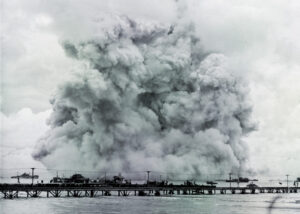Life in Mr. Lincoln’s Navy, by Dennis J. Ringle, Naval Institute Press, Annapolis, Maryland, 800-233-8764, 202 pages, $32.95.
Daily life in the Northern and Southern armies has been the subject of considerable scholarship. Volumes devoted to the letters home of a single soldier can fill more than one bookshelf, while reenactments of famous battles often include replications of camp life. Much less attention has been paid to the lives of Civil War sailors, who appear to have been poor correspondents and whose life aboard ship does not lend itself to reenactment.
The Civil War saw a huge expansion of the Old Navy, one that took place in a period of transition from sail to steam and from wooden ships to ironclads. In Life in Mr. Lincoln’s Navy, Dennis J. Ringle details the discomfort of life aboard ironclads, where ventilation was rudimentary, engine room temperatures could reach 160 degrees, and a trip to the head was fraught with peril: “To make Monitor a functional craft at sea, [John] Ericsson designed a flushing toilet located inside the ship…. The new invention, however, required some mechanical knowledge to be used properly. If the sailor failed to open the overhead valve when he flushed the toilet, the effluent had only one direction to go: up and over the beleaguered sailor.” A sailor aboard the ironclad U.S.S. Cincinnati described his ship as “not fit for a dog to live in.”
The greatest enemy of the Civil War sailor was monotony. A blockader might spend two months or more on station, within sight of land but without seeing an enemy. Day followed day of holystoning decks, squaring the yards, and mending and washing clothes, interspersed with drills involving a variety of antique weaponry. (According to Ringle, the cutlass remained in the U.S. Navy inventory until 1949.)
The U.S. Navy had abolished flogging in 1850, but discipline aboard ships was rigorous. The standard punishment for drunkenness was confinement in double irons, and the length of such confinement was at the discretion of the skipper. Aboard the Kearsarge, sailors who returned drunk from liberty were placed in a canvas straitjacket and chained to the deck. Elsewhere, a sailor found guilty of theft was required to wear a jacket with the word “thief” stenciled on it.
To the despair of many sailors, the U.S. Congress abolished the traditional grog ration in 1862. In compensation, however, the availability of canned foods permitted a more varied diet. According to the author, the Union sailor was better fed than his army counterpart, in part because of an efficient logistical system. Supply vessels kept blockaders provided with fresh meat, vegetables, and ice. Still, most sailors were occasionally obliged to fall back on the staples of an earlier day: hardtack and salt pork.
Besides better food than his army counterpart, the Yankee sailor also had better medical treatment. During the Civil War, one out of 12 Federal soldiers died of disease. In the navy, the ratio was one out of 50. There were several reasons for the discrepancy, among them the fact that sanitation was better at sea. Moreover, the complement of many ships included a doctor.
Throughout the war, the navy compensated its sailors at a rate comparable to merchant marine salaries, and by paying an additional 25 percent to men assigned to monitors, the navy laid a foundation for the hazardous-duty pay that is in vogue today. Nevertheless, the Union navy experienced periodic personnel shortages. The North’s constant need to fill the ranks of its armies took precedence over the navy’s needs and provoked a serious manpower shortage in 1864. The Navy Department fell back on civilian recruiting agencies, many of which were unscrupulous and enlisted foreigners whenever they were available; in 1864, 35 percent of the crew on Admiral David G. Farragut’s flagship, the U.S.S. Hartford, were foreigners.
Life in Mr. Lincoln’s Navy will find a place in the libraries of many navy buffs. Ringle has organized his material well, setting the stage with an introductory chapter in which he describes the navy at the outset of the war, when the pay for an ordinary seaman was $10 per month and the navy had only 12 vessels in U.S. waters. He has made good use of ships’ logs and muster rolls, as well as pertinent manuscript sources in documenting the life of the Yankee tar.
John M. Taylor
McLean, Virginia




